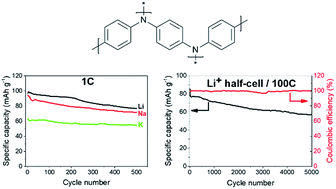An ultrafast charging polyphenylamine-based cathode material for high rate lithium, sodium and potassium batteries†
Abstract
We report the synthesis and investigation of a novel redox-active poly(N,N′-diphenyl-p-phenylenediamine) (PDPPD) material obtained via the Buchwald–Hartwig C–N cross-coupling reaction. PDPPD has a high density of redox-active amine groups enabling a theoretical specific capacity of 209 mA h g−1, which is much higher than that of all other materials of this family reported so far. The obtained polymer was evaluated as a cathode material for dual-ion batteries and it demonstrated promising operating voltages of 3.5–3.7 V and decent practical gravimetric capacities of 97, 94 and 63 mA h g−1 in lithium, sodium and potassium half-cells, respectively, while being tested at a moderate current density of 1C. A specific capacity of 84 mA h g−1 was obtained for ultrafast lithium batteries operating at 100C (full charge and discharge takes 36 seconds only), which is, to the best of our knowledge, the highest battery capacity reported so far for such high current densities. The PDPPD//Li batteries also showed promising stability reflected in 67% capacity retention after 5000 charge–discharge cycles.



 Please wait while we load your content...
Please wait while we load your content...